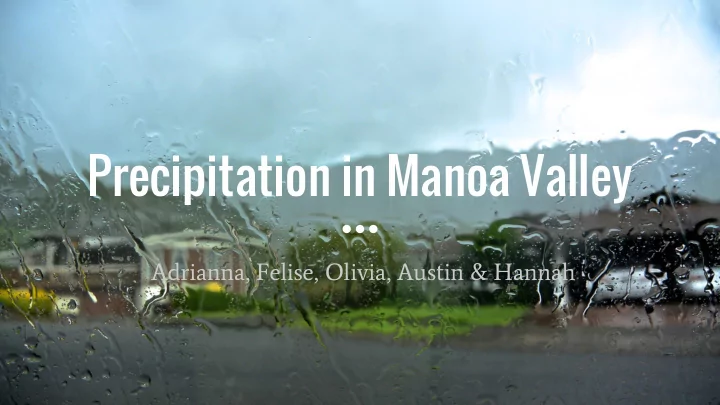

Precipitation in Manoa Valley Adrianna, Felise, Olivia, Austin & Hannah
P + CWI + IRR Precipitation, cloud water interception, and irrigation provide the ability for runoff and evapotranspiration to occur.
Introduction Objectives.. - Attain data from input sources: Precipitation, Cloud Water Interception and Irrigation - Two site stations: Lyon (upper) ○ ○ Mauka (lower) - Rainfall monitored September 2nd- November 4th, battery died towards the end which affected later values
Daily Rainfall Compared...
Mean monthly rainfall from the Atlas of Hawaii compared to the classes recorded data...
Methods -Divided Manoa valley into 3 different sections to split up surveying (upper, lower and mid valleys) -Walked door to door surveying anyone that would talk to us in each section -Asked about watering habits, and approximate square footage of lawn -Used the bucket method to find water flow from a hose, and applied that to square footage of lawn/garden -
4. If you use a hose, what pressure does the hose run? 1. Do you water your yard? a) full pressure a) Yes b) half pressure b) No (if answered no, do not continue) c) low pressure 2. Do you water your yard with a hose or with 5. If you use sprinklers, on average how long do your sprinklers? sprinklers run? a) Hose a) 1-10 minutes b) Sprinklers b) 10-20 minutes c) Both c) 20-30 minutes d) 30-40 minutes 3. If you use a hose, on average how long does it e) 40+ minutes take you to water your yard? a) 1-10 minutes 6. About how many days out of the week do you water b) 10-20 minutes your yard? c) 20-30 minutes a) 1-2 days d) 30-40 minutes b) 3-4 days e) 40+ minutes c) 5-6 days d) Everyday 7. What is the approximate square footage of your yard space? ______________________________ sq ft. Thank you for your time!
Methods Cont.. Irrigation: Bucket Method Average low pressure: 6.23 minutes Measured the volume of a cooler= Average high pressure: 1.32 minutes 47.3 Liters Divided the volume by the time it took to fill the Used a stopwatch to measure the time it bucket to find the flow rate takes in minutes for a hose to fill the bucket at different pressure Low pressure flow rate: 7.59 liters per minute Took the average of multiple trials of High pressure flow rate: 35.83 liters per minute filling the bucket
Irrigation Survey Sites Upper Valley (21.329268, -147.803212) Mid Valley (21.315804, -157.810981) (21.308989, -157.802010) Lower Valley (21.306758, -157.820975) (21.305442, -157.813220) (21.308000, -157.816139)
Proposed Irrigation Area - Upper & mid valley zero irrigation - Blue shaded area indicates proposed irrigation area 11,187,443m ^2 = Total Watershed Area 58,573m ^2 = Each grid square Total approx area of irrigation zone = 1,464,325m ^2 - 2.49mm of Irrigation per grid 25 grids x 2.49mm = 62.25mm 62.25mm of irrigation is added to the inputs of the water balance for the recorded time period.
Methods Cont.. Interpolation Methods - Normal Ratio - Inverse Distance Weighting Cloud Water Interception - Determined which grids were above 2,000 ft - Used leeward side ratio values for each month Measurements - Distance: Km - Rainfall: mm
CWI Map - CWI forms in grids 50% or more above the blue line - The blue line is a contour line of 2,000ft - CWI only affects 7.8% of our watershed
GRAPH TWO
Total Precip: Entire Watershed - Upper Valley = 626,547m^3 - Mid Valley = 210,747m^3 - Lower Valley = 250,618m^3
FINAL FIGURES Total Precipitation: Total IRR: Total CWI: 1,087,532 m^3 91,154.23 m^3 30,218.43 m^3
Results ➔ The results show - Rainy season in September ➔ - Dry season in October ➔ - More rainfall at Lyon then the monthly ➔ mean values - Little to no CWI influence ➔ - Irrigation has a small role in water ➔ balance, none in the middle and back of the valley ➔
Summary - Precipitation is vital to the water cycle - NR and IDW method to interpolate grids - Ratio method for CWI - September experienced high rainfall - It was much drier in October - The upper valley only experiences CWI - The lower valley only has irrigation
Bibliography - Engott, J.A., Johnson, A.G., Bassiouni, Maoya, and Izuka, S.K., 2015, Spatially distributed groundwater recharge for 2010 land cover estimated using a water-budget model for the Island of O‘ahu, Hawai‘i: U.S. Geological Survey Scientific Investigations Report 2015–5010, 49 p., http://dx.doi.org/10.3133/sir20155010. - Giambelluca, Thomas W, Qi Chen, Abby Frazier, Jonathan Price, Yi Leng Chen, and Pao-Shin Chu. 2013. “Online Rainfall Atlas of Hawaii,” no. March: 313–16. doi:10.1175/BAMS-D-11-00228.1. - Frazier, Abby G, Thomas W Giambelluca, F Diaz, and Heidi L Needham. 2016. “Comparison of Geostatistical Approaches to Spatially Interpolate Month-Year Rainfall for the Hawaiian Islands” 1470 (August 2015): 1459–70. doi:10.1002/joc.4437. -
Over to you RUNOFF!
Recommend
More recommend